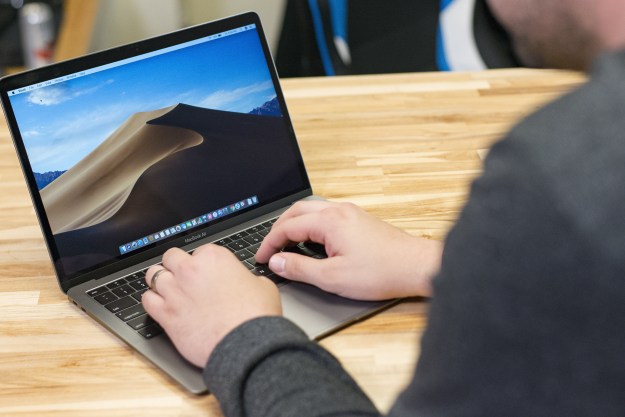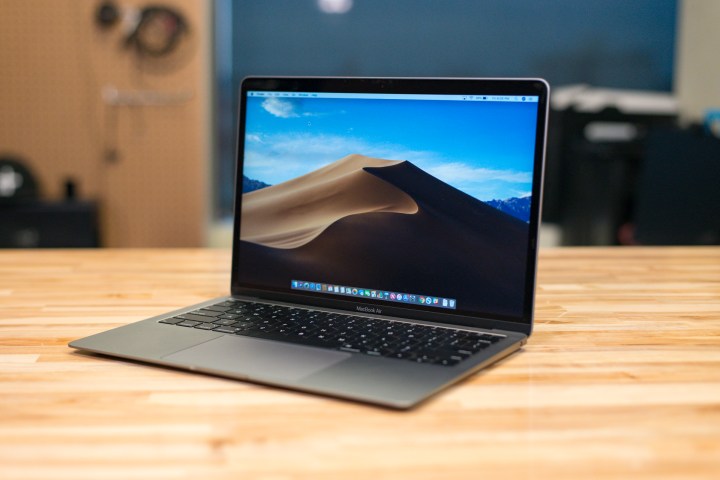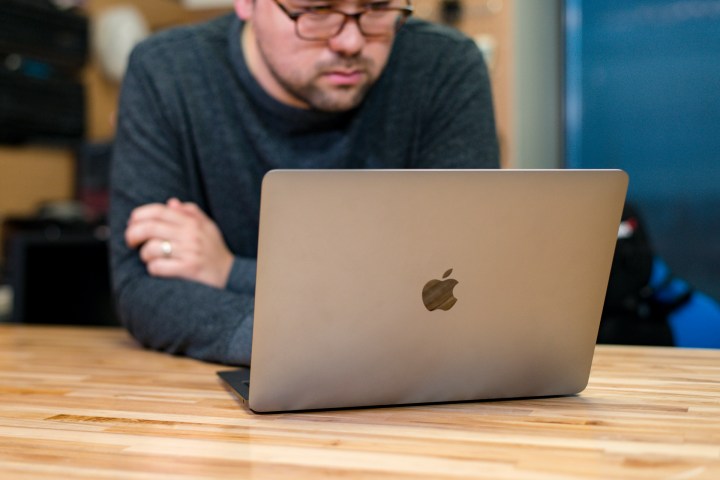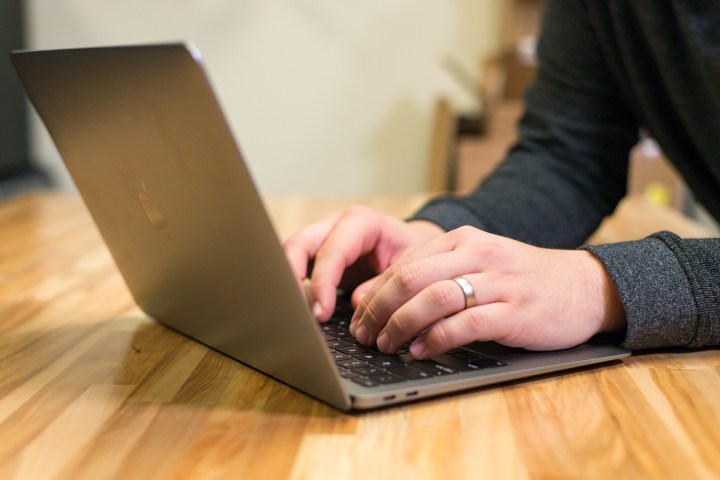
“The MacBook Air gives Apple fans what they want -- at a price.”
- Beautiful, thin, and light
- Excellent build quality
- Improved keyboard and trackpad
- Touch ID
- Loud, clear speakers
- Not a good value
- Below average battery life
- Display is dim and overly saturated
Editor note: Apple has updated the MacBook in Air 2020 with new processors and the Magic Keyboard.
Apple doesn’t concern itself much with what people think its devices “ought” to be like. From missing headphone jacks to shallow keyboards, the company makes a ton of money doing what it thinks is right — not listening directly to fans.
That is, until Apple announced it would resurrect the dusty MacBook Air brand. It’s the update we always wanted for this laptop: an 8th-gen Core i5 processor, Retina display, modern keyboard and trackpad, Touch ID, and Thunderbolt 3 ports. What more could we ask for?
A lower price, to start. At $1,200, the new Air shows we should be careful what we wish for.
Sure, call it a MacBook “Air”
There was a time when no laptop looked quite like one of the best MacBooks. These days, the Apple logo is one of the only signifiers left to separate a MacBook from the piles of other laptops available. Whether it’s the Dell XPS 13, MateBook X Pro, or Surface Laptop 2, discerning owner have more choice than ever before.
The same goes for weight and thickness, two areas that were once the MacBook Air’s defining strengths. The ZenBook 13 UX333FN and Dell XPS 13 are both thinner and lighter, while the Surface Laptop 2 is almost exactly its equal. The Air still has a wedge design, but calling this an “Air” feels a little silly, especially since Apple has other laptops that are even thinner and lighter. These days, the MacBook Air isn’t special. It’s just another laptop.
One feature we’re glad we don’t see in the Macbook Air is the Touch Bar.
Still, you’ll find Apple’s quality in tiny details — fewer panels, creaks, bends, and friction points. The choice in materials, and a new gold colorway, feel unique and robust. The chassis as a whole holds up every bit as well as the $1,600 MacBook Pro and will probably last you longer than any of the internal components will.
The same goes for ports. The USB-A, HDMI, microSD slot, and beloved MagSafe charging port have been abandoned for two Thunderbolt 3 ports. We’ve grown used to the sort of port selection and the benefits of Thunderbolt 3 now outweighs the occasional inconvenience — though we occasionally miss an SD card slot or USB-A port. Being able to charge your phone, plug in a 4K monitor, improve the graphics with an eGPU, and power your laptop all in a single port feels a little like magic. Just love the included headphone jack while you still have it.
The third-gen butterfly keyboard almost gets it right
The Air has the third-generation butterfly keyboard, featured in the most recent 2018 MacBook Pro update. While the new version features a similar low-travel typing experience as the 12-inch MacBook and MacBook Pro, it is slightly quieter this time around. Those that didn’t like the shallow travel still won’t like it, though. It’s still jarring to switch between the MacBook Air’s keyboard and something like the Dell XPS 13, but we were able to type quickly and accurately.

The third-generation butterfly keyboard also adds a plastic membrane beneath each keycap to protect it against dust and dirt, a problem that plagued previous iterations of this keyboard.
As for the touchpad, it’s the same Force Touch keyboard we’ve seen on MacBooks since 2015 — and it’s still the best in the biz. It’s spacious, the palm or thumb rejection is perfect, and the tracking is precise. For detailed work like selecting text, dragging windows, or multi-touch gestures, the MacBook Air reigns supreme.
More from Apple
- Apple will fix these iPhone X, 13-inch MacBook Pro issues for free
- iPad Pro (2018) review
- Apple Mac Mini (2018) Review
Another feature borrowed from the MacBook Pro is Touch ID, located in the top right corner of the keyboard deck. It’s one of the better fingerprint scanners on a laptop, rarely misreading fingerprints to unlock or make purchases. However, laptops with Windows Hello face recognition, like the Surface Laptop 2, make the addition feel a bit outdated. To make matters worse, Face ID was brought to the iPad Pro this year, yet skipped the MacBook Air.
One feature we’re glad not to see is the Touch Bar. The expensive OLED bar at the top of the MacBook Pro’s keyboard deck doesn’t add enough value to justify the price. We’re glad the feature was left to high-end models and wasn’t squeezed in here at the expense of more important components. Good choice, Apple.
The display is Retina, but it’s not impressive
Bringing the Retina display to the MacBook Air is a feature Apple fans have wanted since it was first brought to the MacBook Pro in 2012. Six years is a long time to wait, making its arrival feel a bit less triumphant. It’s a 2,560 x 1,600 display, using Apple’s 16:10 aspect ratio. This is a sharper image than most laptops offer at this price point.

But there’s a problem. This isn’t the same excellent screen featured on the MacBook Pro — or even the 12-inch MacBook.
Apple’s displays are generally second to none in key areas like brightness, contrast, color gamut, and color accuracy. That’s not true here.
Brightness, for example, is mediocre. The MacBook Pro’s 13-inch screen maxes out well over 500 nits, which trounces every other laptop. Other options like the Huawei MateBook X Pro and Dell XPS 15 (4K) are over 500 as well. In comparison, the MacBook Air tops off at just 291 nits. That’s just average and, to make matters worse, the glossy coat remains. Glare can be an issue. Other weak spots include contrast and black levels, where the MacBook Air’s screen is behind not only other Macs, but price-competitive PCs.
One area of the MacBook Air’s display does live up to Apple’s reputation, and that’s color accuracy. It ships with a very low rate of color error, which still makes it a decent choice for photographers and graphic designers.
Another strength of the MacBook Air is its speakers. They now face upward, like the MacBook Pro, just as they should be. More than that, these are the clearest speakers you’ll find on a thin 13-inch laptop. Music sounds rich, as does videos and movies. For intense media experiences we still recommend headphones, but there’s enough oomph to fill a room.
Enough performance, just not a lot
The MacBook Air comes with a unique processor at its core. It’s an 8th-gen Core i5 processor, but not the same kind that comes in the XPS 13 or MateBook X Pro. It’s in Intel’s Y-series line, which are lower-powered chips with fewer cores. You’ll find these in ultra-portable laptops like the Pixelbook or the 12-inch MacBook, which aren’t meant to be big performers.
But before you go and write off the MacBook Air, know that Apple has done something unique here. Unlike other Y-series chips, the Core i5-8210Y has a 7-watt TDP instead of 5 watts, which should translate to better performance. The Air also includes a healthy 8GB of RAM in its base model.
In single-core performance, whether that’s in Geekbench or in just observations from daily use, the MacBook Air blitzes forward. If your daily workflow includes watching video, working in Photoshop, word processing, and web browsing, using the MacBook Air feels snappy and smooth. That’s backed up by its impressive Speedometer benchmark, which simulates responsiveness in web apps. If you’re currently using something like the 2016 13-inch MacBook Pro, you’ll notice a bump in overall performance.
It’s multi-core performance where the MacBook Air’s two cores finds its limit. Intel’s 8th-generation processors were boosted significantly in multi-core performance, especially in its U-series processors that gained additional cores (most are now quad-core). Laptops like the Dell XPS 13, Surface Laptop 2, and Huawei MateBook X Pro all have nearly twice the multi-core capability. We hit this limit ourselves when trying to do a few too many things at once, pulling open twenty Chrome tabs, multiple desktops apps, streaming audio on Spotify and video on YouTube, and powering a secondary 4K monitor.

When you consider the components that laptops of similar pricing use, the MacBook Air does seem a bit underpowered.
The same can’t be said for storage performance. The original MacBook Air pioneered the use of SSDs, and the Air continues that legacy by featuring an excellent PCIe NVMe SSD. While it’s no longer a distinguishing feature, the Air has super-quick read and write speeds that make loading files and opening apps lightning-fast.
If you want to game, buy an eGPU
MacBooks have never been gaming machines, and the MacBook Air proves that point. Since 3DMark isn’t compatible with MacOS, we weren’t able to benchmark the Intel UHD Graphics 617. But it’s safe to say these integrated graphics aren’t meant for serious gaming or video rendering.
The Macbook Air’s battery life doesn’t live up to Apple’s promises.
By comparison, the iPad Pro (or even just the iPad) is a more capable gaming machine, with a far larger game library. You can even play Civilization VI, which can barely run on the MacBook Air even with the graphics settings turned down. Thanks to the Thunderbolt 3 ports and some new capabilities in MacOS, hooking up an eGPU is supported, as long as you use an AMD graphics card.
Losing ground in battery life
The one thing that’s stayed the same since the original MacBook Air is battery life. In the past few years, the world has been playing catch-up while laptops like the MacBook Pro have gone backward. With the new Air, Apple again promises twelve hours of battery life of web browsing and thirteen hours of video playback. Those would have been respectable numbers, even in 2018. Unfortunately, battery life didn’t reach those heights in our tests.
We found the MacBook Air lasts around eight hours in light web browsing. That’s still decent — and will push you through most of a full day — but it’s closer to average rather than the leader of the pack. The MateBook X Pro will last you up to nine and a half hours, while the Core i5 1080p version of the XPS 13 will last even an hour longer. Meanwhile, you can expect around x in video playback, which again, is outdone by the same percentages by these other laptops.
If you’re doing more intensive work, you can expect closer to three and a half hours, based on the results from our Basemark web benchmark, which is about an hour less than those same competitors. Similarly, our video loop test produced just over ten hours of playback time, which is more than three hours behind the XPS 13.
With that being said, it’s the best battery life you’ll find on a MacBook right now, picking up around 35 percent more than the MacBook Pro.
Our Take
As the more affordable MacBook, the Air will be the one a lot of people choose — and there are a few good reasons to. It’s a well-rounded MacBook with no huge flaws.
It’s not revolutionary like the original MacBook Air, however. Far from it. This new MacBook Air doesn’t move forward beyond other Macs, much less its many Windows 10 competitors. Many competitive laptops offer a better display, better keyboard, more ports, a quad-core processor, and better battery life.
The Air has just enough problems here to annoy enuthisasts, but not quite enough to deter the average buyer.
Is there a better alternative?
If you’re looking for a MacBook around this price range, we prefer the MacBook Air over the 12-inch MacBook or the base model MacBook Pro. It’s not better in every way, but it’s the most well-balanced of the Macs.
When you step out of the Mac world, you’ll find a wealth of good alternatives, many of which provide better components at a cheaper price. The Huawei MateBook X Pro, Dell XPS 13, Surface Laptop 2, and HP Spectre x360 all provide a better overall package, each in a chassis as premium as the MacBook Air.
How long will it last?
MacBooks are always well-built, and that’s no different here. The MacBook Air should more than a few years, thanks to how sturdy and dependable the chassis is.
Apple also excels is in customer service, and that’s no different here. This time around, the MacBook Air is even a bit easier to fix than other Macs, which means you’ll have better luck getting it fixed if something goes wrong. The MacBook Air comes with a standard one-year limited warranty, but includes the option for up to three years of extended coverage through AppleCare.
Should you buy it?
Yes, but our recommendation is not clear-cut.
If you’re determined to buy a MacBook, this should be the first option you consider. It’s the most well-balanced MacBook available under $1,500. If you’re open to Windows, though, you’ll easily find one of the best laptops that costs less.
Editors' Recommendations
- The 5 best MacBooks for video editing in 2024
- MacBook Pro 16 vs. MacBook Pro 14: The important differences
- The best MacBook to buy in 2024
- Does your Mac really need antivirus software? We asked the experts
- Best refurbished MacBook deals: Get a MacBook Air for $140 and more






